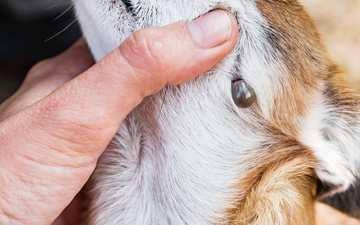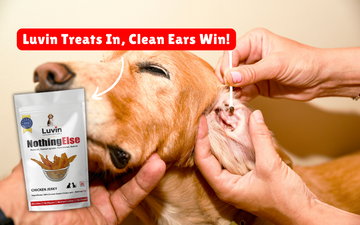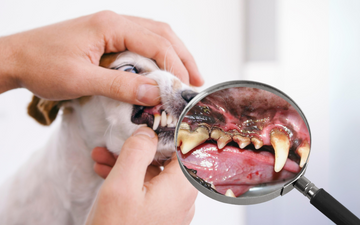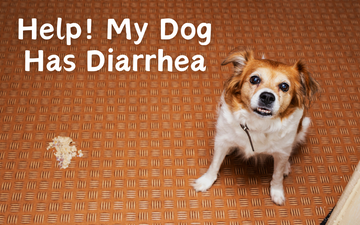
If you are here, you have a huge problem caused by tiny enemies of your doggie, ticks, and fleas.
You give them premium dog food but a small parasite can spoil everything.
Ticks and fleas bite your dog and feast on their blood, potentially transmitting diseases, heard of tick fever?
Signs that your dog is infested
Have you noticed your dog scratching a lot around their head and ears recently? It might be because of those pesky ticks. Sometimes, you can even see red spots on their skin from tick bites. And here's a real telltale sign: if you spot a single tick anywhere in your home, you know you've got a problem. Plus, some dogs are actually allergic to tick bites, so if you see bumps or rashes on their skin, that could be another clue.
You might be searching for the best raw food for dogs with allergies but this may be the wrongdoing of these tiny monsters.
Fleas are tiny bugs that can drink a lot of blood, almost 15 times their own weight. They like to hide under your dog's fur, especially near the tail, on the belly, or around the head. Sometimes, they can even hop onto your bedding or carpets from your pet.
Ticks are bigger parasites that usually grab onto animals when they walk through tall grass or woods. They like to hide near the head, ears, or feet and get bigger as they suck blood. Ticks can also move from your pet to you.
Both these creepy critters feed on blood and can spread diseases.
Handling ticks
How to control ticks in dogs?
Checking your furry friend for ticks can be like playing detective! Here's how you can become a tick investigator.
Make it a daily routine to inspect your pet, especially if they've been out in grassy or wooded areas. Think of it like a daily check-up!
Use your fingers like a comb and gently run them through your pet's fur. You're on a mission to discover any unusual bumps or surprises.
If you find a bump, it's time to investigate further. Part your dog's fur to reveal their skin. Look for a bug that's usually black, brown, or grayish-brown. You might spot the tick's body or even its little legs.
Follow the steps to remove ticks safely
- Put on some gloves to protect yourself.
- Get a pair of tweezers, and grasp the tick close to your pet's skin.
- Gently and slowly pull the tick straight out. Don't twist it.
- Make sure you remove the entire tick, including the head. If a piece stays, try to get it out.
- Wash your pet's skin where the tick was with soap and water.
- Put the tick in a sealed bag or container. You can also flush it down the toilet or put it in alcohol.
Prevention and control of ticks
First, clean up places where ticks like to hide. Things like shrubs, long grass, woodpiles, and crowded flower beds can be cozy homes for ticks.
Next, give your yard a good spray to protect your pets when they're outside.
You can even make your own tick repellent at home if you want to give it a try by taking equal proportions of apple cider vinegar and filtered water (say, 100ml each) and put them in a spray bottle this is one of the best tick treatments for dogs.
Don't forget regular grooming for your pets. It's like a tick shield!
And check your pet and yourself for ticks often. Set a weekly reminder on your phone to make sure you don't forget.
Lastly, chat with your vet and ask them how to prevent ticks, and never miss a dose. You can use Anti-Tick & Flea Spray regularly to help keep them away.
Fleeing Fleas!
You have to get rid of the fleas because the good dog food that you feed your dog ends up in the stomach of the fleas.
When you spot one flea, there's usually a bunch more hiding around. They can bite your pet almost anywhere, but they tend to hang out in these spots:
Around the base of the tail
On the belly and in the groin area
In the armpits
Where your pet has the thickest fur.
When you're checking your dog's skin, keep an eye out for little black specks that resemble finely ground black pepper. These are actually flea 'dirt,' which is digested blood. You'll usually find them near red, irritated patches of skin caused by flea bites.
And watch out for flea eggs – they look like tiny white ovals. If you spot these little white things around where your dog hangs out, like your bed or the carpet, it's a sign that your dog might have fleas.
Prevention and control of fleas!
What is the best flea treatment for dogs?
- Brush and comb your furry friend regularly to check for fleas. This is like giving them a cozy spa day.
- Talk to your pet's doctor about flea protection. They have special stuff like drops, pills, and collars to keep fleas away. Follow their advice.
- Avoid other pets with fleas until your pet is flea-free.
- Get a flea comb and check your pet's fur, especially where fleas hide.
- Use special flea shampoo as your vet suggests to get rid of fleas on your pet.
- Cleanliness is next too no fleas and ticks.






